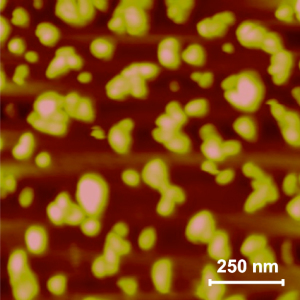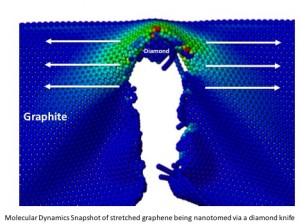I don’t always stumble across the US Department of Agriculture’s nanotechnology research grant announcements but I’m always grateful when I do as it’s good to find out about nanotechnology research taking place in the agricultural sector. From a July 21, 2017 news item on Nanowerk,,
The U.S. Department of Agriculture’s (USDA) National Institute of Food and Agriculture (NIFA) today announced 13 grants totaling $4.6 million for research on the next generation of agricultural technologies and systems to meet the growing demand for food, fuel, and fiber. The grants are funded through NIFA’s Agriculture and Food Research Initiative (AFRI), authorized by the 2014 Farm Bill.
“Nanotechnology is being rapidly implemented in medicine, electronics, energy, and biotechnology, and it has huge potential to enhance the agricultural sector,” said NIFA Director Sonny Ramaswamy. “NIFA research investments can help spur nanotechnology-based improvements to ensure global nutritional security and prosperity in rural communities.”
A July 20, 2017 USDA news release, which originated the news item, lists this year’s grants and provides a brief description of a few of the newly and previously funded projects,
Fiscal year 2016 grants being announced include:
Nanotechnology for Agricultural and Food Systems
- Kansas State University, Manhattan, Kansas, $450,200
- Wichita State University, Wichita, Kansas, $340,000
- University of Massachusetts, Amherst, Massachusetts, $444,550
- University of Nevada, Las Vegas, Nevada,$150,000
- North Dakota State University, Fargo, North Dakota, $149,000
- Cornell University, Ithaca, New York, $455,000
- Cornell University, Ithaca, New York, $450,200
- Oregon State University, Corvallis, Oregon, $402,550
- University of Pennsylvania, Philadelphia, Pennsylvania, $405,055
- Gordon Research Conferences, West Kingston, Rhode Island, $45,000
- The University of Tennessee, Knoxville, Tennessee, $450,200
- Utah State University, Logan, Utah, $450,200
- The George Washington University, Washington, D.C., $450,200
Project details can be found at the NIFA website (link is external).
Among the grants, a University of Pennsylvania project will engineer cellulose nanomaterials [emphasis mine] with high toughness for potential use in building materials, automotive components, and consumer products. A University of Nevada-Las Vegas project will develop a rapid, sensitive test to detect Salmonella typhimurium to enhance food supply safety.
Previously funded grants include an Iowa State University project in which a low-cost and disposable biosensor made out of nanoparticle graphene that can detect pesticides in soil was developed. The biosensor also has the potential for use in the biomedical, environmental, and food safety fields. University of Minnesota (link is external) researchers created a sponge that uses nanotechnology to quickly absorb mercury, as well as bacterial and fungal microbes from polluted water. The sponge can be used on tap water, industrial wastewater, and in lakes. It converts contaminants into nontoxic waste that can be disposed in a landfill.
NIFA invests in and advances agricultural research, education, and extension and promotes transformative discoveries that solve societal challenges. NIFA support for the best and brightest scientists and extension personnel has resulted in user-inspired, groundbreaking discoveries that combat childhood obesity, improve and sustain rural economic growth, address water availability issues, increase food production, find new sources of energy, mitigate climate variability and ensure food safety. To learn more about NIFA’s impact on agricultural science, visit www.nifa.usda.gov/impacts, sign up for email updates (link is external) or follow us on Twitter @USDA_NIFA (link is external), #NIFAImpacts (link is external).
Given my interest in nanocellulose materials (Canada was/is a leader in the production of cellulose nanocrystals [CNC] but there has been little news about Canadian research into CNC applications), I used the NIFA link to access the table listing the grants and clicked on ‘brief’ in the View column in the University of Pennsylania row to find this description of the project,
ENGINEERING CELLULOSE NANOMATERIALS WITH HIGH TOUGHNESS
NON-TECHNICAL SUMMARY: Cellulose nanofibrils (CNFs) are natural materials with exceptional mechanical properties that can be obtained from renewable plant-based resources. CNFs are stiff, strong, and lightweight, thus they are ideal for use in structural materials. In particular, there is a significant opportunity to use CNFs to realize polymer composites with improved toughness and resistance to fracture. The overall goal of this project is to establish an understanding of fracture toughness enhancement in polymer composites reinforced with CNFs. A key outcome of this work will be process – structure – fracture property relationships for CNF-reinforced composites. The knowledge developed in this project will enable a new class of tough CNF-reinforced composite materials with applications in areas such as building materials, automotive components, and consumer products.The composite materials that will be investigated are at the convergence of nanotechnology and bio-sourced material trends. Emerging nanocellulose technologies have the potential to move biomass materials into high value-added applications and entirely new markets.
It’s not the only nanocellulose material project being funded in this round, there’s this at North Dakota State University, from the NIFA ‘brief’ project description page,
NOVEL NANOCELLULOSE BASED FIRE RETARDANT FOR POLYMER COMPOSITES
NON-TECHNICAL SUMMARY: Synthetic polymers are quite vulnerable to fire.There are 2.4 million reported fires, resulting in 7.8 billion dollars of direct property loss, an estimated 30 billion dollars of indirect loss, 29,000 civilian injuries, 101,000 firefighter injuries and 6000 civilian fatalities annually in the U.S. There is an urgent need for a safe, potent, and reliable fire retardant (FR) system that can be used in commodity polymers to reduce their flammability and protect lives and properties. The goal of this project is to develop a novel, safe and biobased FR system using agricultural and woody biomass. The project is divided into three major tasks. The first is to manufacture zinc oxide (ZnO) coated cellulose nanoparticles and evaluate their morphological, chemical, structural and thermal characteristics. The second task will be to design and manufacture polymer composites containing nano sized zinc oxide and cellulose crystals. Finally the third task will be to test the fire retardancy and mechanical properties of the composites. Wbelieve that presence of zinc oxide and cellulose nanocrystals in polymers will limit the oxygen supply by charring, shielding the surface and cellulose nanocrystals will make composites strong. The outcome of this project will help in developing a safe, reliable and biobased fire retardant for consumer goods, automotive, building products and will help in saving human lives and property damage due to fire.
One day, I hope to hear about Canadian research into applications for nanocellulose materials. (fingers crossed for good luck)

